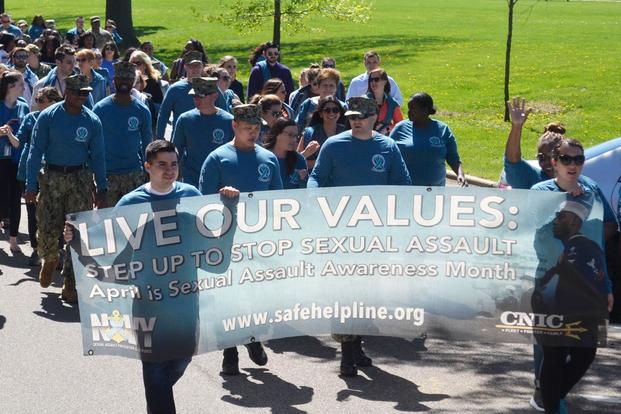A new survey of active-duty troops has found that the number of sexual assaults in the U.S. military rose by 38% from 2016 to 2018, a dramatic increase that comes despite years of efforts to halt rape and other sex crimes in the ranks.
The Defense Department's fiscal 2018 Report on Sexual Assault in the Military, released Thursday, found that roughly 20,500 service members experienced sexual assault, up from an estimated 14,900 in 2016.
The sexual-assault rate for women jumped 50% -- a statistic that some advocates, who have worked for years to change the DoD's approach to sexual-assault prosecution, call "shocking."
"How many more assaults and rapes and how many more victims denied justice must there be before a stubborn and selfish military brass stops fighting reform?" asked retired Col. Don Christensen, a former Air Force chief prosecutor and president of Protect Our Defenders.
Related content:
- Pentagon to Make Sexual Harassment a Crime Under UCMJ
- Shanahan Launches New Task Force on Military Sexual Assault
- Brass Call for More Accountability to Stop Sexual Assault at Military Academies
- Sexual Assaults Rise Nearly 50 Percent at Service Academies
The 20,500 figure is derived from survey results of Army, Navy, Air Force and Marine Corps personnel. But the actual number of reported incidents of sexual assault has also increased in the past two years, up 26% from 4,794 to 6,053.
This means only a third of all sexual assaults in the U.S. military were reported in 2018 -- not surprising, since 43% of women who did report said they had a negative experience doing so, according to the report.
In nearly 90% of cases, the assailant was another service member and, in 62%, also an acquaintance. Perpetrators tended to be between the ranks of E-3 and E-5, with most being the same grade, or slightly higher than the victim's rank.
Junior enlisted women were at highest risk for sexual assault. According to the report, the national odds that a woman will be sexually assaulted in her lifetime are 1 in 17. But for young military women ages 17 to 20, it is 1 in 8. And for 21- to 24-year-olds, it is 1 in 11.
Alcohol also plays a major role: It was a factor in 62% of assaults.
Acting Defense Secretary Patrick Shanahan sent a memo Wednesday to the Joint Chiefs of Staff saying he planned to make sexual harassment a crime and will introduce a program to encourage reporting to catch repeat offenders.
He called the results of the 2018 report and other studies on military sexual assault "unacceptable."
"To put it bluntly, we are not performing to the standards and expectations we have for ourselves or for each other," Shanahan wrote.
Of the services, the Marine Corps had the worst record of sexual assaults against women, with an incidence rate of nearly 11%, followed by the Navy, 7.5%; the Army, 5.8%; and the Air Force, 4.3%.
The incidence rates among men were significantly lower across the board, with the Navy having the highest at 1%, followed by the Marine Corps, .8%; the Army, .7%; and the Air Force, .5%.
In a statement released Thursday, Marine Corps Commandant Gen. Robert Neller said his service will institute rank-specific leadership training to improve staff non-commissioned officer and officer handling of sexual-assault reports, as well as overhaul its victims advocacy training and increase sexual-assault response coordinator training.
"All Marines must be involved in preventing and addressing sexual assault and harassment. There is no room in the Marine Corps for either of these behaviors," Neller said.
The report follows years of efforts to overhaul the Defense Department's sexual-assault prevention programs and improve the services' handling of reports and prosecutions for sexual assault.
In 2019, several changes were made to the Uniform Code of Military Justice to increase victims' rights and, in 2016, administrative procedures were adapted to ensure that commanders and those investigating took allegations of sexual assault seriously.
Some lawmakers continue to argue that these steps don't go far enough. Sen. Kirsten Gillibrand, D-New York, has been advocating to take away a commander's authority to decide whether to prosecute a sexual-assault case, giving the decision over to military attorneys trained in handling such cases.
Christensen said Thursday's report is proof that the current system is failing military personnel.
"The senior military leadership consistently tells Congress that 'commanders are the solution' and to trust them to solve the sexual-assault crisis. Yet for decades, commanders have not been the solution," he said. "It is time for Congress to stop giving the failing military leadership the benefit of the doubt and pass real reform empowering military prosecutors. Enough is enough."
A Marine lance corporal who is among the 20,500 troops sexually assaulted in 2018 told Military.com that the system must be changed to remove command authority. Attacked by a member of the Air Force in March last year, she reported the case, which went to a preliminary hearing.
But while the prosecution wanted to move forward, an Air Force officer with decision authority decided to drop the case.
"I honestly feel if it was in a civilian court, I would have gotten justice. All of it was so disheartening," she said. "I'm currently getting discharged from the Marine Corps for [post-traumatic stress disorder] related to the incident."
In addition to an increase in the number of sexual assaults, sexual harassment and discrimination also are on the rise, according to the report. Roughly a quarter of women said that they experienced sexual harassment and 6% of men said they did, while 16% of women and 2% of men reported gender discrimination. Both were notably higher than in 2016, the report noted.
-- Patricia Kime can be reached at Patricia.Kime@Military.com. Follow her on Twitter at @patriciakime.












